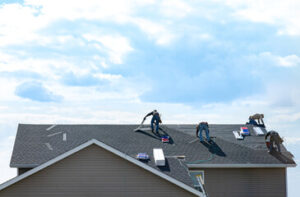Nashville Bathroom Remodeling is a significant project that adds value to your home. However, the extent of this value can vary based on your goals and your future plans for the property.

A remodel can include a complete overhaul of fixtures and finishes to achieve a dramatic transformation. This type of renovation typically requires professional design services and building permits.
A bathroom remodel is different than a renovation. A remodel focuses on making changes that affect the layout, design and appearance of the room. A remodel does not involve changing the footprint of the bathroom or moving plumbing or electrical lines. A renovation, on the other hand, can include those tasks as well as changing the size of the space.
The first step in a successful bathroom remodeling project is to define clear goals. This will help you stay on track, make informed decisions and feel confident in the final result. A professional contractor will help you set realistic goals and work within your budget. This process can help prevent hiccups during construction and reduce the risk of costly surprises down the line.
Another critical aspect of a successful bathroom remodeling project is to plan the layout carefully. A well-designed floor plan can create an open, spacious feeling in a small space. It can also provide you with more design options, such as the ability to fit a tub or shower. If you’re not sure where to start, create multiple floor plans and test out different layouts before deciding.
Once you’ve nailed down your bathroom layout, it’s time to choose materials. There are many different options available, from tubs and showers to cabinets and countertops. Take your time and select products that match your style and meet your needs. For example, consider the amount of storage you need and how much natural light you want in the room.
Another important consideration is to incorporate accessibility features into your bathroom remodel. This can improve the function of the space and allow you to enjoy it for a long time. For example, installing grab bars and walk-in showers can make your bathroom safer and easier to use for people of all ages.
Plumbing
If you want your bathroom remodeling project to go as smoothly as possible, it’s best to leave the plumbing to professionals. This is one of the most important aspects of a bathroom renovation and requires special skills and knowledge. You’ll want to find a contractor with extensive experience and excellent references. It’s also a good idea to ask friends and neighbors for recommendations. Most home warehouse centers also have lists of recommended contractors. You should avoid contractors who advertise in the Yellow Pages or put flyers on your door. These types of contractors are usually laid off workers who are not experienced in contracting work.
Before you begin the plumbing installation process, it’s a good idea to sketch out your design on paper and show it to your general contractor for discussion of feasibility and costs. Your contractor will ensure that all fixtures follow the blueprint and are installed accurately. They will also make sure that all necessary plumbing and electrical connections are made. This includes installing the toilet, tub, shower, and sink. They will also install a new drain and vent, if necessary.
Many homeowners choose to remodel their bathrooms for a number of reasons. Some may have an outdated design, while others simply want to add functionality. Whatever the reason, bathroom remodeling can add value to your home and improve its resale value. It is important to understand the difference between a remodel and renovation, however. While a remodel involves major structural changes and changing the layout of your bathroom, a renovation can be less drastic and include minor improvements such as repainting or adding a vanity. In either case, both projects can add value to your home and improve its appeal.
Electrical
Unlike cosmetic updates, which may simply repaint or redecorate the bathroom, major changes to the layout or design of a bathroom can significantly increase its functionality and increase resale value. These changes often require the assistance of a licensed plumbing contractor to change or install new pipes or fixtures. The contractor will also need to evaluate the existing electrical system to ensure it can handle any additional power use.
Having a functional bathroom is incredibly important for your overall well-being and can add to the resale value of your home. It’s not uncommon for homeowners to want to upgrade their bathrooms to improve the look, feel, and functionality of a room. Adding new lighting, vanity mirrors, and other finishing touches can greatly enhance the appearance of a bathroom and make it more appealing for buyers.
However, the remodeling process can be complex and messy if there are issues with the plumbing or the electrical wiring. For example, many older homes have galvanized or CPVC plumbing that needs to be replaced. These pipes are prone to corrosion and mineral buildup, which can affect water flow and lead to leaks. A professional plumber can install new plumbing lines that are more resistant to these problems and provide improved performance.
Bathrooms also need sufficient lighting, an exhaust fan, and multiple outlets. GFCI (ground fault circuit interrupter) outlets are particularly crucial for areas that are prone to moisture, as they can reduce the risk of electric shocks. Dedicated circuits for items like hair dryers and heated floors are also helpful. A licensed electrician can determine whether your current electrical panel can accommodate these upgrades, or if you need an entirely new one.
Materials
The materials used in bathroom remodeling are crucial for both the functionality and aesthetic of your new space. They must be durable enough to withstand high levels of moisture and frequent cleanings. The type of material you choose should also reflect your personal style and budget.
For instance, if you’re planning to remodel your bathroom with tile floors and walls, consider porcelain and ceramic tiles for their moisture resistance and availability in a wide variety of colors and designs. You can also choose natural stone, which offers a more elegant and timeless appearance. However, it is more expensive and requires regular maintenance and special care to prevent staining.
When it comes to countertops, engineered quartz is a popular choice for bathrooms because it resists heat and is durable. It is also resistant to stains and bacteria, making it easier to clean. Laminate, on the other hand, is a cheap alternative to quartz but can swell up when exposed to moisture and may burn easily from hot hair styling tools.
You should also think about storage when choosing your bathroom materials. Linen closets, shelving and vanity cabinets will help with storage and organization. You can also add extra cabinets to maximize the available space. Choose low-flow toilets and showerheads to save on water usage and improve your home’s energy efficiency.
Choosing the right bathroom materials can be challenging, but setting a budget will help you narrow down your options. It is also important to have the proper tools for the job. Standard tools such as pliers, hammers and tape measures are essential, but you should also purchase specialty carpentry tools like a power saw or a reciprocating saw. These tools will cut through drywall, plywood subfloor and other materials quickly.
Budget
A bathroom remodel is a great way to add value to your home, boost its resale potential and update the design. However, it’s important to make a distinction between “needs” and “wants.” Differentiating between the two will help you create a budget for your project.
As a general rule of thumb, remodeling costs are made up of the cost of materials and labor. Materials can include anything from a new vanity and cabinet to floor tiles and tub. Labor typically accounts for 20% to 65% of your overall remodeling cost. Labor is an especially important aspect to consider, since it includes the costs of plumbing and electrical work.
You should also factor in any unforeseen expenses. A complete remodel typically requires demolition and removal of existing fixtures, which can range in price from $500 to $2,000. Adding new outlets and electrical rewiring will increase your labor costs.
To reduce your overall costs, try to take on some of the work yourself. Simple tasks such as painting or installing easy fixtures can help you save a lot of money on labor. However, complex tasks that involve plumbing and electrical should be left to professionals for safety reasons.
Lastly, don’t forget to account for any finishing touches. Towel bars, toilet paper holders, mirrors and other decorative elements will help bring your remodel to life. It’s worth taking the time to shop around for the best deals and quality products. You’ll be surprised how much a little bit of research can save you! You can often find money-saving components at surplus stores or online. Remember to take advantage of any opportunities for do-it-yourself projects, but don’t attempt any complex or dangerous tasks that could put your family in danger.








